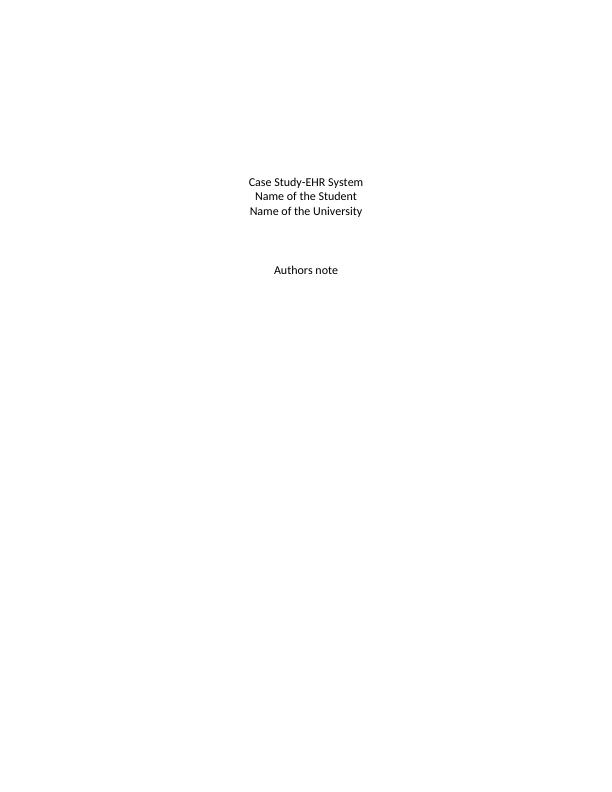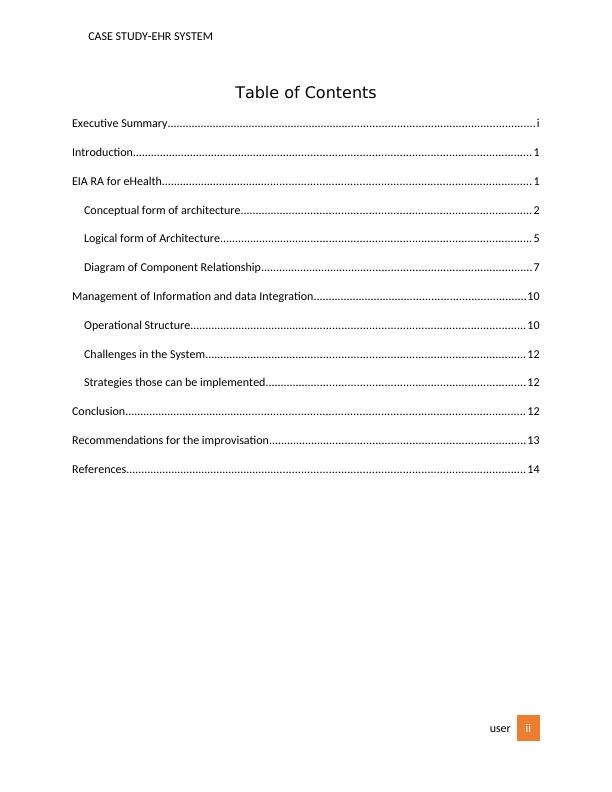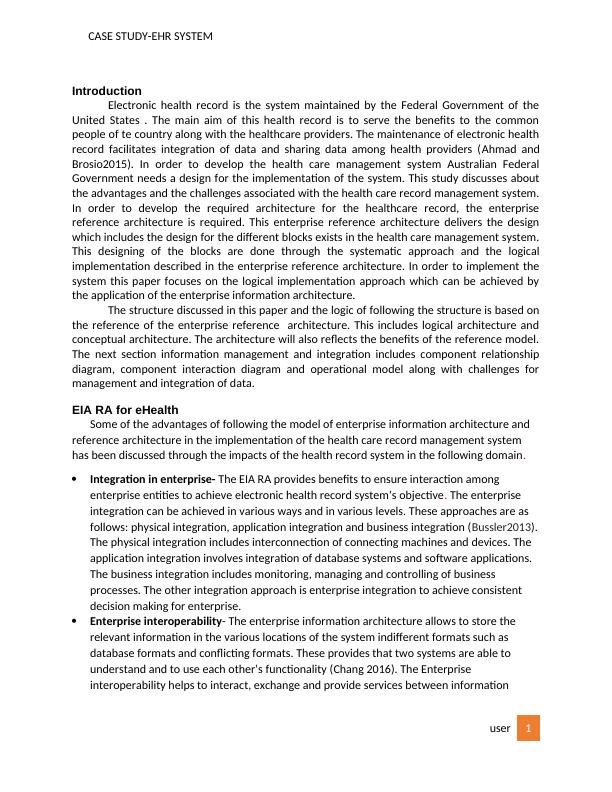Implementation of Health Care Management System using Enterprise Architecture
Added on 2023-06-13
17 Pages3253 Words332 Views
Case Study-EHR System
Name of the Student
Name of the University
Authors note
Name of the Student
Name of the University
Authors note

CASE STUDY-EHR SYSTEM
Executive Summary
The main objective of this report is to propose the implementation of the system that will be
beneficial for managing the health care management system. This paper proposed a way for
the implementation of the health care management system using enterprise resource
modeling. The implementation of the system is done by the enterprise resource management.
This architecture is used to formulate the diagrams that represents requirements for the
electronic health record system. In order to develop the proposed system this paper has
described the components of the system and the relationship and the flow of communication
between the systems components. The overview of the relationship between the different
components helps to understand the system clearly. The paper has also discussed about the
challenges and the opportunities those are present in the current system.
user i
Executive Summary
The main objective of this report is to propose the implementation of the system that will be
beneficial for managing the health care management system. This paper proposed a way for
the implementation of the health care management system using enterprise resource
modeling. The implementation of the system is done by the enterprise resource management.
This architecture is used to formulate the diagrams that represents requirements for the
electronic health record system. In order to develop the proposed system this paper has
described the components of the system and the relationship and the flow of communication
between the systems components. The overview of the relationship between the different
components helps to understand the system clearly. The paper has also discussed about the
challenges and the opportunities those are present in the current system.
user i

CASE STUDY-EHR SYSTEM
Table of Contents
Executive Summary.........................................................................................................................i
Introduction................................................................................................................................... 1
EIA RA for eHealth......................................................................................................................... 1
Conceptual form of architecture............................................................................................... 2
Logical form of Architecture...................................................................................................... 5
Diagram of Component Relationship.........................................................................................7
Management of Information and data Integration......................................................................10
Operational Structure..............................................................................................................10
Challenges in the System.........................................................................................................12
Strategies those can be implemented.....................................................................................12
Conclusion................................................................................................................................... 12
Recommendations for the improvisation....................................................................................13
References................................................................................................................................... 14
user ii
Table of Contents
Executive Summary.........................................................................................................................i
Introduction................................................................................................................................... 1
EIA RA for eHealth......................................................................................................................... 1
Conceptual form of architecture............................................................................................... 2
Logical form of Architecture...................................................................................................... 5
Diagram of Component Relationship.........................................................................................7
Management of Information and data Integration......................................................................10
Operational Structure..............................................................................................................10
Challenges in the System.........................................................................................................12
Strategies those can be implemented.....................................................................................12
Conclusion................................................................................................................................... 12
Recommendations for the improvisation....................................................................................13
References................................................................................................................................... 14
user ii

CASE STUDY-EHR SYSTEM
Introduction
Electronic health record is the system maintained by the Federal Government of the
United States . The main aim of this health record is to serve the benefits to the common
people of te country along with the healthcare providers. The maintenance of electronic health
record facilitates integration of data and sharing data among health providers (Ahmad and
Brosio2015). In order to develop the health care management system Australian Federal
Government needs a design for the implementation of the system. This study discusses about
the advantages and the challenges associated with the health care record management system.
In order to develop the required architecture for the healthcare record, the enterprise
reference architecture is required. This enterprise reference architecture delivers the design
which includes the design for the different blocks exists in the health care management system.
This designing of the blocks are done through the systematic approach and the logical
implementation described in the enterprise reference architecture. In order to implement the
system this paper focuses on the logical implementation approach which can be achieved by
the application of the enterprise information architecture.
The structure discussed in this paper and the logic of following the structure is based on
the reference of the enterprise reference architecture. This includes logical architecture and
conceptual architecture. The architecture will also reflects the benefits of the reference model.
The next section information management and integration includes component relationship
diagram, component interaction diagram and operational model along with challenges for
management and integration of data.
EIA RA for eHealth
Some of the advantages of following the model of enterprise information architecture and
reference architecture in the implementation of the health care record management system
has been discussed through the impacts of the health record system in the following domain.
Integration in enterprise- The EIA RA provides benefits to ensure interaction among
enterprise entities to achieve electronic health record system’s objective. The enterprise
integration can be achieved in various ways and in various levels. These approaches are as
follows: physical integration, application integration and business integration (Bussler2013).
The physical integration includes interconnection of connecting machines and devices. The
application integration involves integration of database systems and software applications.
The business integration includes monitoring, managing and controlling of business
processes. The other integration approach is enterprise integration to achieve consistent
decision making for enterprise.
Enterprise interoperability- The enterprise information architecture allows to store the
relevant information in the various locations of the system indifferent formats such as
database formats and conflicting formats. These provides that two systems are able to
understand and to use each other’s functionality (Chang 2016). The Enterprise
interoperability helps to interact, exchange and provide services between information
user 1
Introduction
Electronic health record is the system maintained by the Federal Government of the
United States . The main aim of this health record is to serve the benefits to the common
people of te country along with the healthcare providers. The maintenance of electronic health
record facilitates integration of data and sharing data among health providers (Ahmad and
Brosio2015). In order to develop the health care management system Australian Federal
Government needs a design for the implementation of the system. This study discusses about
the advantages and the challenges associated with the health care record management system.
In order to develop the required architecture for the healthcare record, the enterprise
reference architecture is required. This enterprise reference architecture delivers the design
which includes the design for the different blocks exists in the health care management system.
This designing of the blocks are done through the systematic approach and the logical
implementation described in the enterprise reference architecture. In order to implement the
system this paper focuses on the logical implementation approach which can be achieved by
the application of the enterprise information architecture.
The structure discussed in this paper and the logic of following the structure is based on
the reference of the enterprise reference architecture. This includes logical architecture and
conceptual architecture. The architecture will also reflects the benefits of the reference model.
The next section information management and integration includes component relationship
diagram, component interaction diagram and operational model along with challenges for
management and integration of data.
EIA RA for eHealth
Some of the advantages of following the model of enterprise information architecture and
reference architecture in the implementation of the health care record management system
has been discussed through the impacts of the health record system in the following domain.
Integration in enterprise- The EIA RA provides benefits to ensure interaction among
enterprise entities to achieve electronic health record system’s objective. The enterprise
integration can be achieved in various ways and in various levels. These approaches are as
follows: physical integration, application integration and business integration (Bussler2013).
The physical integration includes interconnection of connecting machines and devices. The
application integration involves integration of database systems and software applications.
The business integration includes monitoring, managing and controlling of business
processes. The other integration approach is enterprise integration to achieve consistent
decision making for enterprise.
Enterprise interoperability- The enterprise information architecture allows to store the
relevant information in the various locations of the system indifferent formats such as
database formats and conflicting formats. These provides that two systems are able to
understand and to use each other’s functionality (Chang 2016). The Enterprise
interoperability helps to interact, exchange and provide services between information
user 1

End of preview
Want to access all the pages? Upload your documents or become a member.
Related Documents
EHR System using EIA RAlg...
|19
|3291
|176
Enterprise Information Architecture Reference Architecture for EHR systemlg...
|19
|3085
|457
Data and System Integrationlg...
|14
|2990
|408
Data and System Integration in Healthcare: Benefits and Challengeslg...
|16
|3207
|491
EIA RA in Developing a National EHR Systemlg...
|12
|3843
|399
Data and System Integrationlg...
|13
|2888
|65
